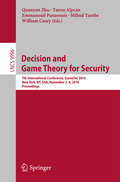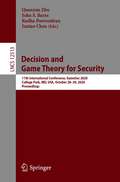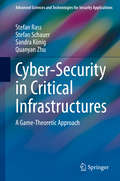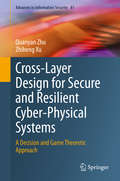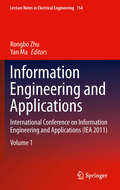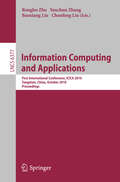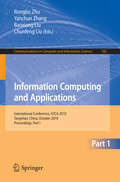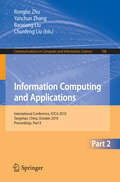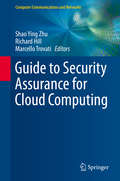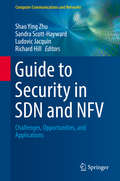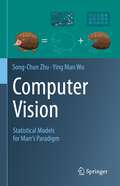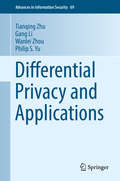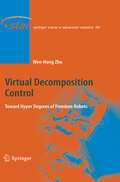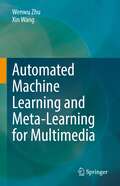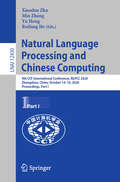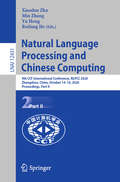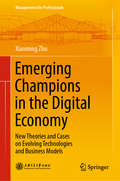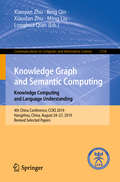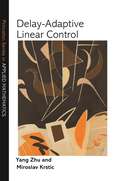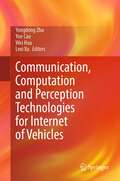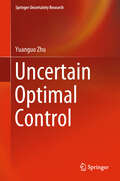- Table View
- List View
Decision and Game Theory for Security: 7th International Conference, GameSec 2016, New York, NY, USA, November 2-4, 2016, Proceedings (Lecture Notes in Computer Science #9996)
by Quanyan Zhu Tansu Alpcan Emmanouil Panaousis Milind Tambe William CaseyThis book constitutes the refereed proceedings of the 7th International Conference on Decision and Game Theory for Security, GameSec 2016, held in New York, NY, USA, in November 2016. The 18 revised full papers presented together with 8 short papers and 5 poster papers were carefully reviewed and selected from 40 submissions. The papers are organized in topical sections on network security; security risks and investments; special track-validating models; decision making for privacy; security games; incentives and cybersecurity mechanisms; and intrusion detection and information limitations in security.
Decision and Game Theory for Security: 11th International Conference, GameSec 2020, College Park, MD, USA, October 28–30, 2020, Proceedings (Lecture Notes in Computer Science #12513)
by Quanyan Zhu John S. Baras Radha Poovendran Juntao ChenThis book constitutes the refereed proceedings of the 11th International Conference on Decision and Game Theory for Security, GameSec 2020,held in College Park, MD, USA, in October 2020. Due to COVID-19 pandemic the conference was held virtually The 21 full papers presented together with 2 short papers were carefully reviewed and selected from 29 submissions. The papers focus on machine learning and security; cyber deception; cyber-physical systems security; security of network systems; theoretic foundations of security games; emerging topics.
Cyber-Security in Critical Infrastructures: A Game-Theoretic Approach (Advanced Sciences and Technologies for Security Applications)
by Quanyan Zhu Stefan Rass Stefan Schauer Sandra KönigThis book presents a compendium of selected game- and decision-theoretic models to achieve and assess the security of critical infrastructures. Given contemporary reports on security incidents of various kinds, we can see a paradigm shift to attacks of an increasingly heterogeneous nature, combining different techniques into what we know as an advanced persistent threat. Security precautions must match these diverse threat patterns in an equally diverse manner; in response, this book provides a wealth of techniques for protection and mitigation. Much traditional security research has a narrow focus on specific attack scenarios or applications, and strives to make an attack “practically impossible.” A more recent approach to security views it as a scenario in which the cost of an attack exceeds the potential reward. This does not rule out the possibility of an attack but minimizes its likelihood to the least possible risk. The book follows this economic definition of security, offering a management scientific view that seeks a balance between security investments and their resulting benefits. It focuses on optimization of resources in light of threats such as terrorism and advanced persistent threats. Drawing on the authors’ experience and inspired by real case studies, the book provides a systematic approach to critical infrastructure security and resilience. Presenting a mixture of theoretical work and practical success stories, the book is chiefly intended for students and practitioners seeking an introduction to game- and decision-theoretic techniques for security. The required mathematical concepts are self-contained, rigorously introduced, and illustrated by case studies. The book also provides software tools that help guide readers in the practical use of the scientific models and computational frameworks.
Cross-Layer Design for Secure and Resilient Cyber-Physical Systems: A Decision and Game Theoretic Approach (Advances in Information Security #81)
by Quanyan Zhu Zhiheng XuThis book introduces a cross-layer design to achieve security and resilience for CPSs (Cyber-Physical Systems). The authors interconnect various technical tools and methods to capture the different properties between cyber and physical layers. Part II of this book bridges the gap between cryptography and control-theoretic tools. It develops a bespoke crypto-control framework to address security and resiliency in control and estimation problems where the outsourcing of computations is possible. Part III of this book bridges the gap between game theory and control theory and develops interdependent impact-aware security defense strategies and cyber-aware resilient control strategies.With the rapid development of smart cities, there is a growing need to integrate the physical systems, ranging from large-scale infrastructures to small embedded systems, with networked communications. The integration of the physical and cyber systems forms Cyber-Physical Systems (CPSs), enabling the use of digital information and control technologies to improve the monitoring, operation, and planning of the systems. Despite these advantages, they are vulnerable to cyber-physical attacks, which aim to damage the physical layer through the cyber network.This book also uses case studies from autonomous systems, communication-based train control systems, cyber manufacturing, and robotic systems to illustrate the proposed methodologies. These case studies aim to motivate readers to adopt a cross-layer system perspective toward security and resilience issues of large and complex systems and develop domain-specific solutions to address CPS challenges.A comprehensive suite of solutions to a broad range of technical challenges in secure and resilient control systems are described in this book (many of the findings in this book are useful to anyone working in cybersecurity). Researchers, professors, and advanced-level students working in computer science and engineering will find this book useful as a reference or secondary text. Industry professionals and military workers interested in cybersecurity will also want to purchase this book.
Information Engineering and Applications: International Conference on Information Engineering and Applications (IEA 2011) (Lecture Notes in Electrical Engineering #154)
by Rongbo Zhu Yan MaIn past twenty years or so, information technology has influenced and changed every aspect of our lives and our cultures. Without various IT-based applications, we would find it difficult to keep information stored securely, to process information and business efficiently, and to communicate information conveniently. In the future world, ITs and information engineering will play a very important role in convergence of computing, communication, business and all other computational sciences and application and it also will influence the future world's various areas, including science, engineering, industry, business, law, politics, culture and medicine. The International Conference on Information Engineering and Applications (IEA) 2011 is intended to foster the dissemination of state-of-the-art research in information and business areas, including their models, services, and novel applications associated with their utilization. International Conference on Information Engineering and Applications (IEA) 2011 is organized by Chongqing Normal University, Chongqing University, Shanghai Jiao Tong University, Nanyang Technological University, University of Michigan and the Chongqing University of Arts and Sciences, and is sponsored by National Natural Science Foundation of China (NSFC). The objective of IEA 2011 is to will provide a forum for engineers and scientists in academia, industry, and government to address the most innovative research and development . Information Engineering and Applications provides a summary of this conference including contributions for key speakers on subjects such as technical challenges, social and economic issues, and ideas, results and current work on all aspects of advanced information and business intelligence.
Information Computing and Applications: First International Conference, ICICA 2010, Tangshan, China, October 15-18, 2010, Proceedings (Lecture Notes in Computer Science #6377)
by Rongbo Zhu Yanchun Zhang Baoxiang Liu Chunfeng LiuInformation Computing and Applications, Part I: International Conference, ICICA 2010, Tangshan, China, October 15-18, 2010. Proceedings, Part I (Communications in Computer and Information Science #105)
by Rongbo Zhu Yanchun Zhang Baoxiang Liu Chunfeng LiuInformation Computing and Applications, Part II: International Conference, ICICA 2010, Tangshan, China, October 15-18, 2010. Proceedings, Part II (Communications in Computer and Information Science #106)
by Rongbo Zhu Yanchun Zhang Baoxiang Liu Chunfeng LiuThis volume contains the proceedings of the International Conference on Inf- mation Computing and Applications (ICICA 2010), which was held in Tangshan, China, October 15-18, 2010. As future-generation information technology, information computing and applications become specialized, information computing and applications - cluding hardware, software, communications and networks are growing with ever-increasing scale and heterogeneity and becoming overly complex. The c- plexity is getting more critical along with the growing applications. To cope with the growing and computing complexity, information computing and applications focus on intelligent, selfmanageable, scalable computing systems and applications to the maximum extent possible without human intervention or guidance. With the rapid development of information science and technology, infor- tion computing has become the third approach of science research. Information computing and applications is the ?eld of study concerned with constructing - telligent computing, mathematical models, numerical solution techniques and using computers to analyze and solve natural scienti?c, social scienti?c and engineering problems. In practical use, it is typically the application of c- puter simulation, intelligent computing, internet computing, pervasive comp- ing, scalable computing, trusted computing, autonomy-oriented computing, evolutionary computing, mobile computing, computational statistics, engine- ing computing, multimedia networking and computing, applications and other forms of computation problems in various scienti?c disciplines and engine- ing. Information computing and applications is an important underpinning for techniques used in information and computational science and there are many unresolved problems that address worth studying.
Guide to Security Assurance for Cloud Computing (Computer Communications and Networks #0)
by Shao Ying Zhu Richard Hill Marcello TrovatiThis practical and didactic text/reference discusses the leading edge of secure cloud computing, exploring the essential concepts and principles, tools, techniques and deployment models in this field. Enlightening perspectives are presented by an international collection of pre-eminent authorities in cloud security assurance from both academia and industry.Topics and features:· Describes the important general concepts and principles of security assurance in cloud-based environments· Presents applications and approaches to cloud security that illustrate the current state of the art· Reviews pertinent issues in relation to challenges that prevent organizations moving to cloud architectures· Provides relevant theoretical frameworks and the latest empirical research findings· Discusses real-world vulnerabilities of cloud-based software in order to address the challenges of securing distributed software· Highlights the practicalities of cloud security, and how applications can assure and comply with legislation· Includes review questions at the end of each chapterThis Guide to Security Assurance for Cloud Computing will be of great benefit to a broad audience covering enterprise architects, business analysts and leaders, IT infrastructure managers, cloud security engineers and consultants, and application developers involved in system design and implementation. The work is also suitable as a textbook for university instructors, with the outline for a possible course structure suggested in the preface.The editors are all members of the Computing and Mathematics Department at the University of Derby, UK, where Dr. Shao Ying Zhu serves as a Senior Lecturer in Computing, Dr. Richard Hill as a Professor and Head of the Computing and Mathematics Department, and Dr. Marcello Trovati as a Senior Lecturer in Mathematics. The other publications of the editors include the Springer titles Big-Data Analytics and Cloud Computing, Guide to Cloud Computing and Cloud Computing for Enterprise Architectures.
Guide to Security in SDN and NFV: Challenges, Opportunities, and Applications (Computer Communications and Networks)
by Shao Ying Zhu Sandra Scott-Hayward Ludovic Jacquin Richard HillThis book highlights the importance of security in the design, development and deployment of systems based on Software-Defined Networking (SDN) and Network Functions Virtualization (NFV), together referred to as SDNFV. Presenting a comprehensive guide to the application of security mechanisms in the context of SDNFV, the content spans fundamental theory, practical solutions, and potential applications in future networks.Topics and features: introduces the key security challenges of SDN, NFV and Cloud Computing, providing a detailed tutorial on NFV security; discusses the issue of trust in SDN/NFV environments, covering roots of trust services, and proposing a technique to evaluate trust by exploiting remote attestation; reviews a range of specific SDNFV security solutions, including a DDoS detection and remediation framework, and a security policy transition framework for SDN; describes the implementation of a virtual home gateway, and a project that combines dynamic security monitoring with big-data analytics to detect network-wide threats; examines the security implications of SDNFV in evolving and future networks, from network-based threats to Industry 4.0 machines, to the security requirements for 5G; investigates security in the Observe, Orient, Decide and Act (OODA) paradigm, and proposes a monitoring solution for a Named Data Networking (NDN) architecture; includes review questions in each chapter, to test the reader’s understanding of each of the key concepts described.This informative and practical volume is an essential resource for researchers interested in the potential of SDNFV systems to address a broad range of network security challenges. The work will also be of great benefit to practitioners wishing to design secure next-generation communication networks, or to develop new security-related mechanisms for SDNFV systems.
Computer Vision: Statistical Models for Marr's Paradigm
by Song-Chun Zhu Ying Nian WuAs the first book of a three-part series, this book is offered as a tribute to pioneers in vision, such as Béla Julesz, David Marr, King-Sun Fu, Ulf Grenander, and David Mumford. The authors hope to provide foundation and, perhaps more importantly, further inspiration for continued research in vision. This book covers David Marr's paradigm and various underlying statistical models for vision. The mathematical framework herein integrates three regimes of models (low-, mid-, and high-entropy regimes) and provides foundation for research in visual coding, recognition, and cognition. Concepts are first explained for understanding and then supported by findings in psychology and neuroscience, after which they are established by statistical models and associated learning and inference algorithms. A reader will gain a unified, cross-disciplinary view of research in vision and will accrue knowledge spanning from psychology to neuroscience to statistics.
Differential Privacy and Applications (Advances in Information Security #69)
by Tianqing Zhu Gang Li Wanlei Zhou Philip S. YuThis book focuses on differential privacy and its application with an emphasis on technical and application aspects. This book also presents the most recent research on differential privacy with a theory perspective. It provides an approachable strategy for researchers and engineers to implement differential privacy in real world applications.Early chapters are focused on two major directions, differentially private data publishing and differentially private data analysis. Data publishing focuses on how to modify the original dataset or the queries with the guarantee of differential privacy. Privacy data analysis concentrates on how to modify the data analysis algorithm to satisfy differential privacy, while retaining a high mining accuracy. The authors also introduce several applications in real world applications, including recommender systems and location privacy Advanced level students in computer science and engineering, as well as researchers and professionals working in privacy preserving, data mining, machine learning and data analysis will find this book useful as a reference. Engineers in database, network security, social networks and web services will also find this book useful.
Virtual Decomposition Control: Toward Hyper Degrees of Freedom Robots (Springer Tracts in Advanced Robotics #60)
by Wen-Hong ZhuDriven by the need to achieve superior control performances for robots with hyper degrees of freedom, the virtual decomposition control approach is thoroughly presented in this book. This approach uses subsystem (such as links and joints of a complex robot) dynamics to conduct control design, while guaranteeing the stability and convergence of the entire complex robot without compromising the rigorousness of the system analysis. The central concept of this approach is the definition of the virtual stability. The stability of the entire complex robot is mathematically equivalent to the virtual stability of every subsystem. This fact allows us to convert a large problem to a few simple problems with mathematical certainty. This book comprises fourteen chapters. The first five chapters form the foundation of this approach. The remaining nine chapters are relatively independent. Starting from Chapter 6, each chapter deals with a particular type of systems including motor/transmission assemblies, hydraulic robots, coordinated multiple robots, space robots, humanoid robots, adaptive teleoperation, and modular robot manipulators. At the end, the extensions of this approach to distributed-parameter systems and to electrical circuits are given, paving the way for other applications to follow. This book is intended for practitioners, researchers, and graduate students who have acquired fundamental knowledge on robotics and control systems and have been committed to achieving the best control performances on complex robotics systems and beyond.
Automated Machine Learning and Meta-Learning for Multimedia
by Wenwu Zhu Xin WangThis book disseminates and promotes the recent research progress and frontier development on AutoML and meta-learning as well as their applications on computer vision, natural language processing, multimedia and data mining related fields. These are exciting and fast-growing research directions in the general field of machine learning. The authors advocate novel, high-quality research findings, and innovative solutions to the challenging problems in AutoML and meta-learning. This topic is at the core of the scope of artificial intelligence, and is attractive to audience from both academia and industry.This book is highly accessible to the whole machine learning community, including: researchers, students and practitioners who are interested in AutoML, meta-learning, and their applications in multimedia, computer vision, natural language processing and data mining related tasks. The book is self-contained and designed for introductory and intermediate audiences. No special prerequisite knowledge is required to read this book.
Natural Language Processing and Chinese Computing: 9th CCF International Conference, NLPCC 2020, Zhengzhou, China, October 14–18, 2020, Proceedings, Part I (Lecture Notes in Computer Science #12430)
by Xiaodan Zhu Min Zhang Yu Hong Ruifang HeThis two-volume set of LNAI 12340 and LNAI 12341 constitutes the refereed proceedings of the 9th CCF Conference on Natural Language Processing and Chinese Computing, NLPCC 2020, held in Zhengzhou, China, in October 2020.The 70 full papers, 30 poster papers and 14 workshop papers presented were carefully reviewed and selected from 320 submissions. They are organized in the following areas: Conversational Bot/QA; Fundamentals of NLP; Knowledge Base, Graphs and Semantic Web; Machine Learning for NLP; Machine Translation and Multilinguality; NLP Applications; Social Media and Network; Text Mining; and Trending Topics.
Natural Language Processing and Chinese Computing: 9th CCF International Conference, NLPCC 2020, Zhengzhou, China, October 14–18, 2020, Proceedings, Part II (Lecture Notes in Computer Science #12431)
by Xiaodan Zhu Min Zhang Yu Hong Ruifang HeThis two-volume set of LNAI 12340 and LNAI 12341 constitutes the refereed proceedings of the 9th CCF Conference on Natural Language Processing and Chinese Computing, NLPCC 2020, held in Zhengzhou, China, in October 2020.The 70 full papers, 30 poster papers and 14 workshop papers presented were carefully reviewed and selected from 320 submissions. They are organized in the following areas: Conversational Bot/QA; Fundamentals of NLP; Knowledge Base, Graphs and Semantic Web; Machine Learning for NLP; Machine Translation and Multilinguality; NLP Applications; Social Media and Network; Text Mining; and Trending Topics.
Emerging Champions in the Digital Economy: New Theories and Cases on Evolving Technologies and Business Models (Management for Professionals)
by Xiaoming ZhuThis book presents a list of emerging and established companies which have a strong belief in the digital economy and elaborate their unique digital innovations. The companies selected for this book are from a variety of industries, including both Chinese and international leading technology companies such as iflytek, JD.com, IBM and Amazon. A wide range of commercial fields are covered ensuring a comprehensive research on the topic of digital economy, for example Shanghai Center (Construction Management), PPDai(Finance), 3Dmed(Precision Medicine), Children’s Hospital of Shanghai(Medical Service), First Respond (First Aid Service) etc. All cases are presented based on field studies as well as in-depth interviews and are followed by thought-provoking case analysis, which can help readers to better understand the cases from different perspectives. Readers can use this book as a good reference to address challenges and capture opportunities in the context of ever growing digital economy.
Knowledge Graph and Semantic Computing: 4th China Conference, CCKS 2019, Hangzhou, China, August 24–27, 2019, Revised Selected Papers (Communications in Computer and Information Science #1134)
by Xiaoyan Zhu Ming Liu Bing Qin Xiaodan Zhu Longhua QianThis book constitutes the refereed proceedings of the 4th China Conference on Knowledge Graph and Semantic Computing, CCKS 2019, held in Hangzhou, China, in August 2019. The 18 revised full papers presented were carefully reviewed and selected from 140 submissions. The papers cover wide research fields including the knowledge graph, the semantic Web, linked data, NLP, information extraction, knowledge representation and reasoning.
Fraud Prevention in Online Digital Advertising (SpringerBriefs in Computer Science)
by Xingquan Zhu Haicheng Tao Zhiang Wu Jie Cao Kristopher Kalish Jeremy KayneThe authors systematically review methods of online digital advertising (ad) fraud and the techniques to prevent and defeat such fraud in this brief. The authors categorize ad fraud into three major categories, including (1) placement fraud, (2) traffic fraud, and (3) action fraud. It summarizes major features of each type of fraud, and also outlines measures and resources to detect each type of fraud. This brief provides a comprehensive guideline to help researchers understand the state-of-the-art in ad fraud detection. It also serves as a technical reference for industry to design new techniques and solutions to win the battle against fraud.
Education and Mobilities: Ideas, People and Technologies. Proceedings of the 6th BNU/UCL IOE International Conference in Education (Perspectives on Rethinking and Reforming Education)
by Xudong Zhu Mang Li Qiang Liu Hugh Starkey Jiayong LiThis book gathers selected original papers presented at the Sixth Beijing Normal University - University College London, Institute of Education International Conference in Education, a biennial event organised in partnership between this two universities. Readers will find a wealth of papers and reports on research involving schools and the initial and professional development of teachers, revealing links between research, policy and practice, while also analyzing key themes in education, including public goals and policies, pedagogy, curricula, organisation, resources and technologies, and institutional effectiveness. An essential guide for anyone who wishes to understand the main issues involved in mobilities of ideas, people and technology in the field of education, the book offers an extensive introduction, and can also be used as a resource for empirical and conceptual research into related issues.
Delay-Adaptive Linear Control (Princeton Series in Applied Mathematics #70)
by Yang Zhu Miroslav KrsticActuator and sensor delays are among the most common dynamic phenomena in engineering practice, and when disregarded, they render controlled systems unstable. Over the past sixty years, predictor feedback has been a key tool for compensating such delays, but conventional predictor feedback algorithms assume that the delays and other parameters of a given system are known. When incorrect parameter values are used in the predictor, the resulting controller may be as destabilizing as without the delay compensation.Delay-Adaptive Linear Control develops adaptive predictor feedback algorithms equipped with online estimators of unknown delays and other parameters. Such estimators are designed as nonlinear differential equations, which dynamically adjust the parameters of the predictor. The design and analysis of the adaptive predictors involves a Lyapunov stability study of systems whose dimension is infinite, because of the delays, and nonlinear, because of the parameter estimators. This comprehensive book solves adaptive delay compensation problems for systems with single and multiple inputs/outputs, unknown and distinct delays in different input channels, unknown delay kernels, unknown plant parameters, unmeasurable finite-dimensional plant states, and unmeasurable infinite-dimensional actuator states.Presenting breakthroughs in adaptive control and control of delay systems, Delay-Adaptive Linear Control offers powerful new tools for the control engineer and the mathematician.
Failure-Modes-Based Software Reading (SpringerBriefs in Computer Science)
by Yang-Ming ZhuIdentifying failure modes and their effects is critical to software failure mode and effects analysis and it largely depends on the analysts’ experience and the skill. This book develops a series of reading techniques based on common and prioritized failure modes in software requirements, software design, coding, and usability in order to makes the benefits of software failure mode and effects analysis (FMEA) readily accessible to general software practitioners, particularly in small teams and resource-constrained organizations.After a general introduction it offers an overview of software FMEA and discusses software review procedures and software reading techniques. Subsequent chapters present the basic ideas behind failure-modes-based reading techniques and examine the use of these techniques for software requirements, software design, software coding, software usability, and software testing. Covering the entire creation process, and including checklists and examples, it provides an easy introduction to the topic for professionals in software engineering and quality assurance.
Software Reading Techniques: Twenty Techniques for More Effective Software Review and Inspection
by Yang‐Ming ZhuLearn twenty software reading techniques to enhance your effectiveness in reviewing and inspecting software artifacts such as requirements specifications, designs, code files, and usability. Software review and inspection is the best practice in software development that detects and fixes problems early. Software professionals are trained to write software but not read and analyze software written by peers. As a result, individual reading skills vary widely. Because the effectiveness of software review and inspection is highly dependent on individual reading skills, differential outcomes among software readers vary by a factor of ten. Software Reading Techniques is designed to close that gap.Dr Yang‐Ming Zhu’s depth of experience as a software architect, team leader, and scientist make him singularly well-equipped to bring you up to speed on all the techniques and tips for optimizing the effectiveness and efficiency of your software review and inspection skills.What You'll Learn:Improve software review, inspection procedures, and reading skillsStudy traditional and modern advanced reading techniques applicable to software artifactsMaster specific reading techniques for software requirements specification, software design, and codeWho This Book Is For:Software professionals and software engineering students and researchers
Communication, Computation and Perception Technologies for Internet of Vehicles
by Yongdong Zhu Yue Cao Wei Hua Lexi XuThis book focuses on the design, management, and cybersecurity of connected and autonomous vehicles under the umbrella of the Internet of Vehicles. Both principles and engineering practice are covered, from the design perspectives of communication, computing, and perception to ITS management. An in-depth study of a range of topics such as microscopic traffic behavior modeling and simulation, localization, V2X communication, cooperative cloud-edge computing, and multi-sensor fusion for perception has been presented, while novel enabling technologies such as RIS and blockchain are introduced. The book benefits researchers, engineers, and graduate students in the fields of intelligent transport systems, telecommunications, cybersecurity, and autonomous driving.
Uncertain Optimal Control (Springer Uncertainty Research)
by Yuanguo ZhuThis book introduces the theory and applications of uncertain optimal control, and establishes two types of models including expected value uncertain optimal control and optimistic value uncertain optimal control. These models, which have continuous-time forms and discrete-time forms, make use of dynamic programming. The uncertain optimal control theory relates to equations of optimality, uncertain bang-bang optimal control, optimal control with switched uncertain system, and optimal control for uncertain system with time-delay. Uncertain optimal control has applications in portfolio selection, engineering, and games. The book is a useful resource for researchers, engineers, and students in the fields of mathematics, cybernetics, operations research, industrial engineering, artificial intelligence, economics, and management science.
